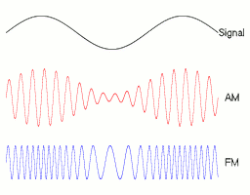There are so many different radio transmissions it’s hard to understand why they don’t interfere with each other. The key is that all these different signals each exist at a different frequency.
This may freak you out
It’s kind of like this: You can take a yellow light, and shine it against the wall and the wall will look yellow. You can take a blue light and shine it across the path of the yellow light and the wall will still look yellow. The blue light is at a different frequency so it doesn’t interfere with the yellow light. Even if they are both shining at the same spot, you could use a filter to take out the blue light and you would still have yellow light. Pretty trippy, right?

Signals that carry TV, cell phones, radio and satellite all travel at really different frequencies. Satellite signals especially travels at a super-high frequency so it is more immune to loss through the atmosphere. Frequency is measured in thousands of cycles per second/kilohertz (kHz), millions of cycles per second/megahertz (MHz) or billions of cycles per second (GHz). An AM radio signal might be 1070 kHz, while a TV signal is more around 600MHz, and a satellite signal is about 15GHz. They’re quite different.
Let’s back up: what is frequency?
Light and radio waves are all part of the electromagnetic spectrum. In other words, on the most basic level it’s all the same thing: energy traveling over distance. If you remember anything from high school science, you might remember that sometimes it’s useful to talk about radio frequency radiation as particles, and sometimes it’s useful to talk about it as waves. We’re not going to use the whole “particle” thing here, because it’s not useful to us.
So, think about waves in the ocean. They come into the shore at a certain speed. One crashes about every 10-15 seconds. Imagine if they crashed faster or slower. That’s kind of what we mean by frequency.

Ignore the scary math, I just chose this graphic to show two different frequencies. At the left is a low-frequency wave. At the right is a higher-frequency wave.
What’s the difference between low and high frequency?
We humans tend to interact with electromagnetic radiation in very weird ways. Depending on its frequency, it affects us differently. Some frequencies get interpreted as heat, others as light. Some frequencies, like X-rays, don’t really affect us unless we get a lot of exposure. Other frequencies don’t affect us really at all. It’s the ones that don’t affect us at all that are used for radio, TV, cellular, and other forms of broadcasting.
The whole key to broadcasting is actually putting a usable signal on a certain frequency. It’s done through modulation.
What’s modulation?
Radio and TV signals that come from towers on the ground use either AM, meaning amplitude modulation, or FM meaning frequency modulation. In other words the wave either gets stronger and weaker (AM) or faster and slower (FM) as it represents different information. Satellite signals use much more complex digital forms of storage that are harder to explain.

If we take a signal, overlay it on a certain frequency, and pump it out with enough power, then that signal can be received and decoded. And that, my friends, is how you get practically everything wirelessly.





